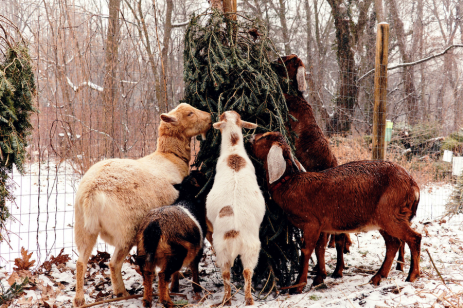Finding a sustainable way to recycle, or “tree-cycle,” your Christmas tree will keep the holiday spirit going all year.
Recycling is great. But Christmas tree-cycling? Even better. According to the Pennsylvania Christmas Tree Growers Association, Pennsylvania ranks third in the United States for the number of Christmas tree farms. There are more than 1,400 Christmas tree farms in Pennsylvania producing more than one million cut trees every year.
The good news is that many of these holiday trees are recycled after the holidays and why not? There are so many interesting and easy ways to recycle your tree. What is normally a bittersweet task—dismantling the tree and all its festive bling—can be a fun way to help goats, fish, birds, and beaches. Here are suggestions for ways to tree-cycle your tree:
Like goats?
Goats love to eat pine needles, and the needles are a great source of greens, fiber, and vitamins for them. Goats also love to snack on the bark from Christmas trees, especially balsam fir. You can bring your pre-cut holiday tree, with all decorations and tinsel removed, to a local goat farm that accepts trees such as the Philly Goat Project at Awbury Arboretum in Philadelphia. In 2020, the goats at the Philly Goat Project polished off more than 300 holiday trees. Many goat farms are looking for volunteers to help at tree-cycling events too. “The process of taking care of the tree skeletons left after the goats eat the needles is considerable,” said Karen Krivit, Director of the Philly Goat Project. “We pay for wood chipping and have many volunteers moving and hauling trees all over for months after the holidays.”
For the birds
Birds are a beautiful sight in the bare winter months and will feast on a holiday tree reborn as a huge bird feeder in addition to enjoying the tree as a source of warmth and shelter.
“Winter feeder birds need a thermal cover, and conifers can be a good source of this warmth and protection from the elements,” said Ron Rohrbaugh, Director of Conservation Science and Forest Programs for Audubon Mid-Atlantic. He suggests tying your holiday tree, clean of all ornaments and tinsel, to an adjacent tree for stability against the wind and re-decorating the tree with pine cones with peanut butter and bird seed. Others suggest leaving the tree in the holiday tree stand and weighting it with rocks or stakes. Garlands of unsalted popcorn (salt is bad for birds) as well as apple and orange slices will delight local winter birds from downy woodpeckers to black-capped chickadees, white-breasted nuthatch, tufted titmouse, juncos and more. For more tips see How to Convert Your Christmas Tree to a Bird Feeder.
How about fish?
Recycled Christmas trees can be a gift for fish. Sunken trees can help create a richer aquatic habitat where smaller prey fish such as sunfish and perch can protect themselves from predators. Studies have found that species richness, diversity, and abundance of fish – from prey fish to insect-loving fish like yellow perch, bluegill, and small yellow perch as well as predator fish like bass and walleye, tends to increase with the presence of submerged trees with complex branching. See the Penn State Extension article: Christmas Trees a Gift for the Fish .
Recycle at the beach
If you live close enough, you might consider taking your tree to the beach for recycling. Beaches use recycled trees to stop beach erosion. The trees are buried on the beach with sand and the trees help hold the sand together during storms. One such program takes place in Ocean County, New Jersey. Residents can bring trees to most of the many county parks to recycle and the trees are made into wood chips for the parks.
Local conservation efforts and community parks
Trees can be donated to help conservation efforts in the community. Trees have been used in preventing stream erosion. A line of Christmas trees have been anchored to the streambank, which lessens the impact of the water on the bank and traps sediment to help restore the bank. Also, check to see if your local municipality recycles Christmas trees into wood chips to be used as mulch in the parks.
If you have young children, you can read to them about the adventures of recycling holiday trees. Pennsylvania resident Lynne Samson’s new book Once Upon a Pine Tree is about trees reimagining themselves after the holidays to help rebuild sand dunes, feed birds and chipmunks, and turn back into soil for the earth.
With a little planning, your tree-cycling efforts can extend the holiday spirit well into the New Year.




